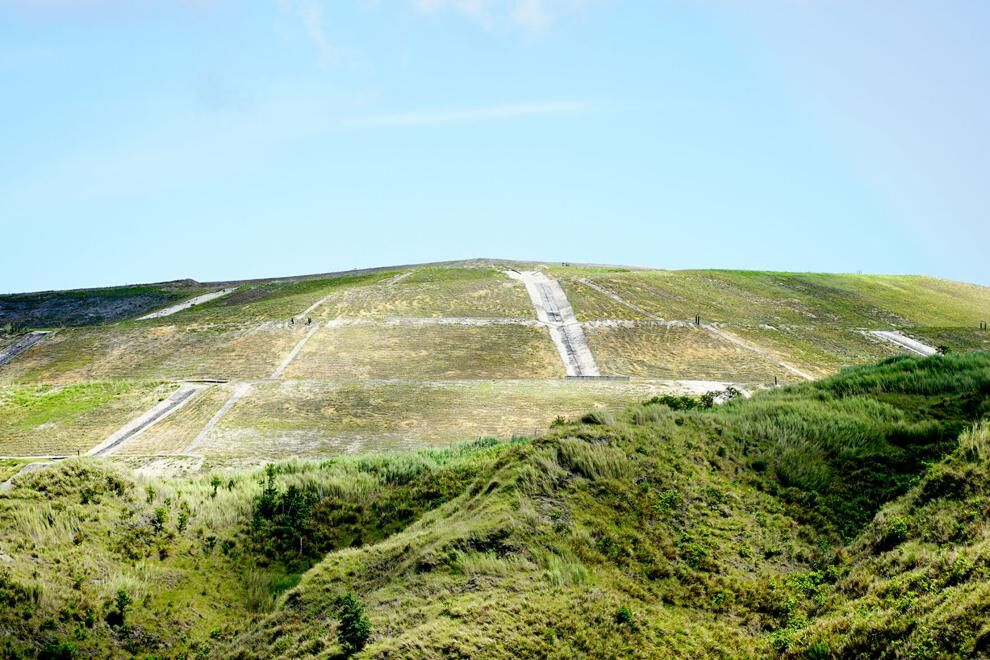HAGÅTÑA (The Guam Daily Post) — Leachate pumps at the Ordot dump stopped working during Typhoon Mawar and leachate overflowed from the secondary containment system at the facility.
“So it had a release to the (Lonfit) River, based on the rainfall event,” Guam Solid Waste Authority General Manager Irvin Slike told board members during a meeting Wednesday.
It’s believed that rainfall runoff substantially diluted the leachate overflow, rendering it “insignificant,” although facility staff didn’t have an opportunity to sample the water, according to an incident report sent to the Guam Environmental Protection Agency. The report was submitted by Brown and Caldwell Constructors, on behalf of federal receiver Gershman, Brickner & Bratton Inc.
Based on pre-storm and post-storm pumping rates, it was estimated that between 66,000 and 100,000 gallons of leachate may have overflowed from the secondary containment. But that didn’t take into account potentially available storage capacity in the leachate tanks and the secondary containment, Brown and Caldwell said in the report.
“The estimated overflow volume does not reflect a reduction in overflow volume due to available storage in the tanks (potentially 27,700 gallons) or secondary storage (potentially 29,500 gallons),” the report stated. “Accounting for the potentially available storage capacity would reduce the estimated overflow volumes to 8,880 gallons and 42,800 gallons, respectively.”
It’s estimated the pumps may have stopped operating between 5 and 9 p.m. on May 24, about nine to 13 hours after staff visited the site that morning.
Staff arriving at the dump around 1 p.m. May 25, after the typhoon, realized the flowmeter serving the leachate collection system was registering zero gallons per minute, but the emergency generator powering the pumps was still operating.
The reason for the pump failure was unknown at the time of the incident report. Brown and Caldwell was awaiting an evaluation by a pump system contractor to determine the cause, if possible.
The ground around the leachate storage tanks sloped to a stormwater basin about 50 feet away. That basin discharges onto the ground surface about 200 feet from the Lonfit River, according to the incident report.
“It is estimated that approximately 9.4 million gallons of rainfall-runoff was discharged in Stormwater Basin #3 during the storm,” the report stated. “While facility staff did not have an opportunity to sample water in Stormwater Basin #3, we believe the rainfall-runoff entering the basin substantially diluted the overflow from the secondary containment, rendering it insignificant.”
The Guam Daily Post is awaiting information from Guam EPA on the overflow.
Storms and closed landfills
Rain can increase leachate production on open landfills, but the Ordot site has been closed and capped.
At the GSWA meeting Wednesday, Slike said he sent a message to the solid waste director in central Florida, asking what her experience has been with closed landfills after hurricane events.
“What I got back from the department was, generally, closed landfills don’t really have any abnormal amounts of leachate that come out of them,” Slike said Wednesday.
He sent subsequent emails to solid waste entities at counties in Florida, asking them to share typical leachate production for their closed landfills after a storm event.
“A typhoon hit Guam three weeks ago with 27 inches of rain and the leachate collection system on a closed landfill was inundated and a release was registered,” Slike said in the email.
“This landfill is under court order and the operator claims that leachate production should always occur if it rains,” Slike added. “This has not been my experience in my career on properly closed landfills. On an active landfill, there is an increase in leachate production following rain events, but not typically on closed landfills, even unlined facilities.”
A landfill supervisor in one county said he didn’t have any data other than observations to agree with Slike’s assessment of closed landfills. A superintendent in another county said its closed landfill was capped in 2004. The county monitors gas and groundwater levels, but hasn’t experienced any abnormalities, even in the event of a storm, the superintendent added.
“It does rain a lot on Guam, but if you have a properly closed landfill, you don’t actually breach your leachate collection system. That’s just not heard of,” Slike said Wednesday.
Gershman, Brickner & Bratton was appointed by the federal court in 2008 to oversee the island’s solid waste services. A partial end to the receivership was ordered in 2019, but the company was authorized to continue its work to complete post-closure plans for the Ordot dump.
Slike said he was aware of two leachate containment breaches. The other occurred in 2017, Slike said.

The Ordot dump is shown in this file photo. Leachate pumps at the dump stopped working during Typhoon Mawar and leachate overflowed from the secondary containment system at the facility.











